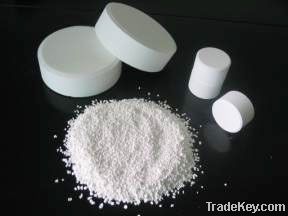


离岸价格
获取最新报价1300 ~ 1400 USD / Metric Ton
|20 Metric Ton Minimum Order
国家:
China
型号:
Purity 90% min
离岸价格:
1300 ~ 1400 USD / Metric Ton 获取最新报价
位置:
Henan
最小订单价格:
1300 per Metric Ton
最小订单:
20 Metric Ton
包装细节:
10kg plastic drum, 25kg plastic drum 50kg plastic drum,
交货时间:
Within 15 days after receiving your workable L/C o
供应能力:
2000 Metric Ton per Month
付款方式:
T/T, L/C
產品組 :
-
联系人 Jessie
NO. 1 Huanghe Road, Zhengzhou, Henan, China, Zhengzhou, Henan
Name: Trichloroisocyanuric acid
Molecular formula: C3O3N3Cl3
Structural formula:
UN
No.: ***8
CAS No.: ******1
Form: white powder, granules or tablets
Moleclar weight: **2.*1
Available chlorine: ≥*0%
Water content: ≤0.5%
Solubility: 1.2g/**0g water
PH value of 1%
solution:2.**3.3
Granules: ***0mesh ****0mesh (or made in
accord with client's requirements)
Tablet specification: 1g, 5g, *0g, *5g, *0g,
*0g, *0g, **0g, **5g, **0g, **0g, **0g, **0g, **0g (or made in
accord with client's requirements)
General Instructions:
1. The correct level of free
chlorine should be maintained for several hours prior to and during
swimming activity.
2. Chlorine and pH should be
tested daily by use of a reliable test kit using fresh testing
reagents.
3. If pH falls below the required
level add pH buffer, if it rises above add hydrochloric acid or dry
acid.
4. Dose pool in the evening when
the pool is not in use.
5. Stabilizer levels should be
tested monthly by your local pool shop or by use of a reliable test
kit.
6. Always add tablets to a
floating dispensing device or feeder designed for either calcium
hypochlorite or trichloroisocyanurate.
Safety Directions:
Highly reactive oxidizing
chlorine compound may cause fire and explosion or produce severe
burns. Product will irritate the eyes, nose, throat and skin. Avoid
contact with skin, eyes, and other clothing. Do not inhale the
dust. Do not allow the product to come into contact with other
chemicals especially acids, or with combustible material such as
paper, fabric, sawdust or kerosene. Do not allow to get damp. Use
clean containers for dispensing. Do not mix with other chemicals.
Do not mix with different types of chlorinating chemicals. Mix with
water only. Do not add water to the product. Add the product to
water, but in case of fire, drench with water. Store undercover in
a dry, clean, cool well ventilated place away from sunlight. Store
and transport in an upright container. In case of spillage, flush
with large quantities of water. Wash hands after use.
First Aid:
1. If poisoning occurs, contact a
doctor or the local hospital.
2. If swallowed, do not induce
vomiting, give a glass of water.
3. If skin contact occurs, remove
contaminated clothing and wash skin thoroughly.
4. If in eyes, hold eyes open,
flood with water for at least *5 minutes and see a
doctor.
Usage:
1.
Trichloroisocyanuric acid(TCCA) can be used in water treatment,
especially in swimming pool water treatment, drinking water
treatment, algae removing of industrial circulating water,
treatment of industrial or city sewage, disinfection of petroleum
well drilling slurry and sewage and productiong of seawater
cells.
3.
Trichloroisocyanuric acid(TCCA) can be used in dishware
disinfection, preventative disinfection of houses, hotels and
public places, hygiene and diseal control in hospitals, and
environment disinfection in fish, silkworm, livestock and poultry
feeding places. Trichloroisocyanuric acid(TCCA) also can be used in
fruits and vegetables disinfection and preservation
.
4.
Moreover, trichloroisocyanuric acid(TCCA) can also be used in
textile cleansing and bleaching, wool shrink resistance, paper
insect resistance, and rubber chlorination, etc.
Benefits of Trichloroisocyanuric acid(TCCA)
in Swimming Pool:
Available with *0% chlorine concentration
Due to high chlorine content, handling is easy for large pools.
Reduces chlorine loss during day time. Trichloroisocyanuric
acid(TCCA) is stable it does not strip like any other halogen
compounds.
Reduces algae growth.
Dissolves slowly in water, Trichloroisocyanuric acid(TCCA) allowing
for continuously metered dosing of available chlorine, especially
when in tablet form.
| 国家: | China |
| 型号: | Purity 90% min |
| 离岸价格: | 1300 ~ 1400 / Metric Ton 获取最新报价 |
| 位置: | Henan |
| 最小订单价格: | 1300 per Metric Ton |
| 最小订单: | 20 Metric Ton |
| 包装细节: | 10kg plastic drum, 25kg plastic drum 50kg plastic drum, |
| 交货时间: | Within 15 days after receiving your workable L/C o |
| 供应能力: | 2000 Metric Ton per Month |
| 付款方式: | T/T, L/C |
| 產品組 : | - |